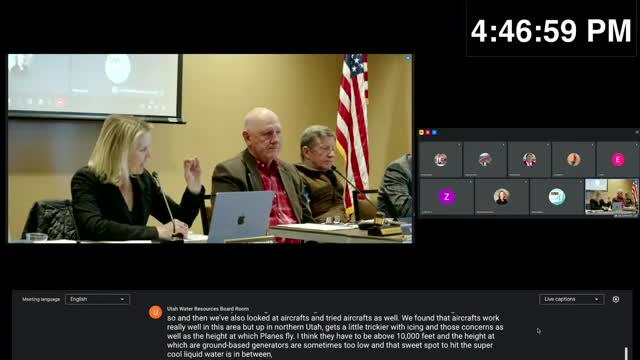Utah invests $3M in cloud seeding and water conservation programs
March 22, 2025 | Natural Resources Department, Utah Environment, State Agencies, Organizations, Utah Executive Branch, Utah
This article was created by AI summarizing key points discussed. AI makes mistakes, so for full details and context, please refer to the video of the full meeting. Please report any errors so we can fix them. Report an error »

In a recent meeting held by the Utah Department of Natural Resources, officials gathered to discuss critical water resource management strategies, highlighting innovative approaches to address the state's ongoing water challenges. The atmosphere was charged with a sense of urgency as discussions ranged from cloud seeding initiatives to conservation efforts and legislative updates.
One of the standout proposals was the allocation of $3 million for drone technology aimed at enhancing cloud seeding operations. This season has seen heightened activity in Northern Utah, particularly in the Great Salt Basin, where successful seeding has already been reported. The East Shore Grama area, stretching from Bountiful to Ogden, is set to benefit from expanded seeding efforts, promising to bolster water supplies in the region.
The meeting also celebrated the successful deployment of $5.1 million in American Rescue Plan Act (ARPA) funds, which have been fully utilized to incentivize landscape conservation. This initiative has led to the replacement of over 3 million square feet of grass statewide, resulting in annual water savings of approximately 100 million gallons. The positive impact of these efforts was underscored by the announcement of a new bipartisan tax parity act, which, if passed, would exempt water conservation rebates from taxation, further encouraging sustainable practices among Utah residents.
As the meeting progressed, officials shared updates on the Great Salt Lake Basin integrated plan, emphasizing ongoing climate and hydrology modeling work in collaboration with the U.S. Bureau of Reclamation and the University of Utah. However, they acknowledged delays in the contracting process, which could hinder timely progress on essential modeling efforts.
The conversation also touched on the Colorado River Authority's recent approval of projects under its demand management pilot program. These initiatives aim to optimize water storage and usage, particularly in light of the ongoing drought affecting the region. The Bear River Commission is set to meet on April 15 to discuss a new water delivery schedule, indicating a proactive approach to managing interstate water resources.
In closing, the meeting reflected a commitment to innovative solutions and collaborative efforts in water management. As Utah faces increasing pressures on its water supply, the strategies discussed could play a pivotal role in ensuring sustainable water resources for future generations. The board's dedication to outreach and education was evident, with plans for local events aimed at fostering community engagement in water conservation efforts.
One of the standout proposals was the allocation of $3 million for drone technology aimed at enhancing cloud seeding operations. This season has seen heightened activity in Northern Utah, particularly in the Great Salt Basin, where successful seeding has already been reported. The East Shore Grama area, stretching from Bountiful to Ogden, is set to benefit from expanded seeding efforts, promising to bolster water supplies in the region.
The meeting also celebrated the successful deployment of $5.1 million in American Rescue Plan Act (ARPA) funds, which have been fully utilized to incentivize landscape conservation. This initiative has led to the replacement of over 3 million square feet of grass statewide, resulting in annual water savings of approximately 100 million gallons. The positive impact of these efforts was underscored by the announcement of a new bipartisan tax parity act, which, if passed, would exempt water conservation rebates from taxation, further encouraging sustainable practices among Utah residents.
As the meeting progressed, officials shared updates on the Great Salt Lake Basin integrated plan, emphasizing ongoing climate and hydrology modeling work in collaboration with the U.S. Bureau of Reclamation and the University of Utah. However, they acknowledged delays in the contracting process, which could hinder timely progress on essential modeling efforts.
The conversation also touched on the Colorado River Authority's recent approval of projects under its demand management pilot program. These initiatives aim to optimize water storage and usage, particularly in light of the ongoing drought affecting the region. The Bear River Commission is set to meet on April 15 to discuss a new water delivery schedule, indicating a proactive approach to managing interstate water resources.
In closing, the meeting reflected a commitment to innovative solutions and collaborative efforts in water management. As Utah faces increasing pressures on its water supply, the strategies discussed could play a pivotal role in ensuring sustainable water resources for future generations. The board's dedication to outreach and education was evident, with plans for local events aimed at fostering community engagement in water conservation efforts.
View full meeting
This article is based on a recent meeting—watch the full video and explore the complete transcript for deeper insights into the discussion.
View full meeting

